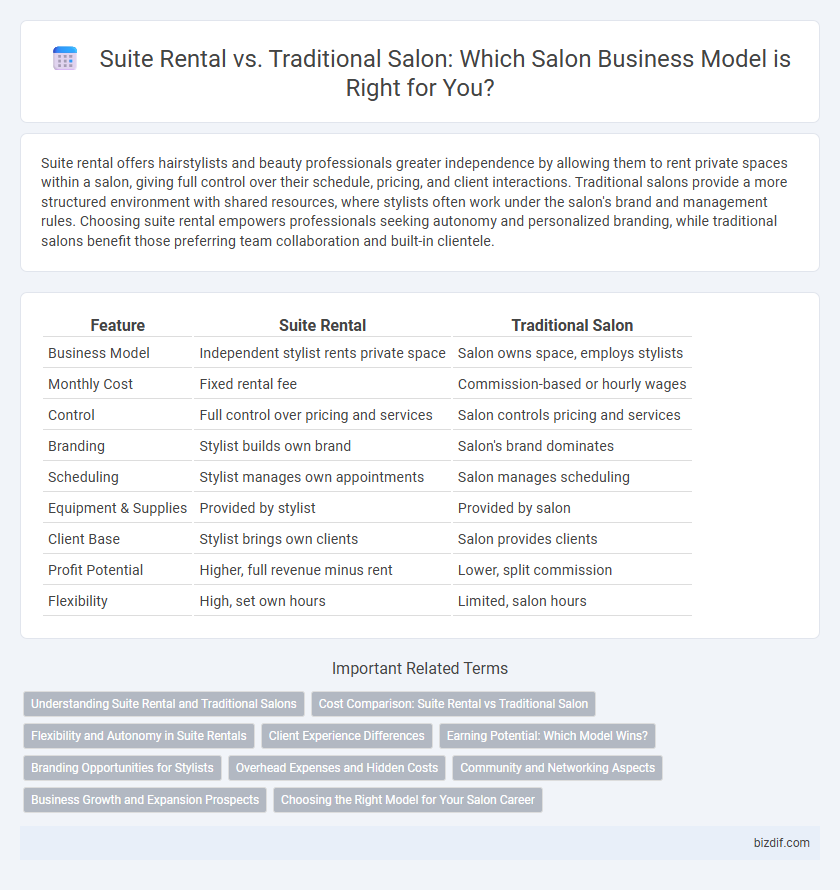Suite rental offers hairstylists and beauty professionals greater independence by allowing them to rent private spaces within a salon, giving full control over their schedule, pricing, and client interactions. Traditional salons provide a more structured environment with shared resources, where stylists often work under the salon's brand and management rules. Choosing suite rental empowers professionals seeking autonomy and personalized branding, while traditional salons benefit those preferring team collaboration and built-in clientele.
Table of Comparison
| Feature | Suite Rental | Traditional Salon |
|---|---|---|
| Business Model | Independent stylist rents private space | Salon owns space, employs stylists |
| Monthly Cost | Fixed rental fee | Commission-based or hourly wages |
| Control | Full control over pricing and services | Salon controls pricing and services |
| Branding | Stylist builds own brand | Salon's brand dominates |
| Scheduling | Stylist manages own appointments | Salon manages scheduling |
| Equipment & Supplies | Provided by stylist | Provided by salon |
| Client Base | Stylist brings own clients | Salon provides clients |
| Profit Potential | Higher, full revenue minus rent | Lower, split commission |
| Flexibility | High, set own hours | Limited, salon hours |
Understanding Suite Rental and Traditional Salons
Suite rental salons offer beauty professionals independent workspaces within a shared building, enabling full control over their schedule, services, and client interactions. Traditional salons operate under a salon owner who provides the space, supplies, and client base, while stylists typically receive a commission or hourly wage. Understanding these models helps professionals choose between autonomy with suite rentals and the support structure of traditional salons.
Cost Comparison: Suite Rental vs Traditional Salon
Suite rentals typically involve a fixed monthly fee ranging from $1,000 to $3,000, allowing stylists to retain 100% of their earnings, whereas traditional salons often charge commission fees between 30% and 50%, reducing stylist income. Initial investment for suite rental includes leasing costs and personal equipment expenses, while traditional salons generally provide equipment but deduct rental fees from stylist pay. Over time, suite rentals may offer higher profit margins but require more financial responsibility and initial capital compared to the more structured, lower-risk model of traditional salon employment.
Flexibility and Autonomy in Suite Rentals
Suite rentals offer unparalleled flexibility and autonomy compared to traditional salon settings, allowing beauty professionals to set their own schedules and personalize their workspace. This model empowers stylists and estheticians to control pricing, services, and booking, fostering a more entrepreneurial approach. Unlike traditional salons, suite rentals eliminate corporate restrictions, enabling professionals to build their brand identity and client base independently.
Client Experience Differences
Suite rental salons provide clients with a personalized and private atmosphere, enhancing comfort and exclusivity compared to traditional salons where multiple stylists work in shared spaces. Clients benefit from direct communication with their stylist, fostering stronger relationships and tailored services not always possible in larger, busier salons. The suite rental model often results in reduced wait times and a more flexible appointment schedule, improving overall client satisfaction.
Earning Potential: Which Model Wins?
Suite rental offers higher earning potential for salon professionals by allowing them to keep 100% of their service income, unlike traditional salons where earnings are often split through commissions or chair rental fees. In a traditional salon, stylists typically earn 40-60% commissions, limiting their income growth despite high client volumes. Suite rental models foster entrepreneurship, enabling professionals to set their prices and manage multiple revenue streams, thereby maximizing overall profitability.
Branding Opportunities for Stylists
Suite rental offers stylists complete control over their brand identity, allowing personalized decor, unique marketing strategies, and direct client engagement, enhancing brand visibility. Traditional salons often provide limited branding opportunities, as stylists work under the salon's established name and marketing efforts, restricting individual branding growth. Personalized branding in suite rentals can lead to higher client loyalty and greater revenue potential for independent stylists.
Overhead Expenses and Hidden Costs
Suite rental salons typically have lower overhead expenses compared to traditional salons, as renters pay a fixed fee covering space and utilities, reducing unpredictable costs. Traditional salons often incur hidden costs such as equipment maintenance, product inventory, and commission fees, which can significantly impact profitability. Understanding these financial differences is crucial for stylists when choosing between suite rental and traditional salon models.
Community and Networking Aspects
Suite rental salons foster a strong sense of community by allowing independent stylists to create personalized spaces while sharing common areas, encouraging collaboration and client exchange. Traditional salons often operate under a single brand or management, which may limit networking opportunities but provide structured support and teamwork among staff. Stylists seeking greater professional autonomy and peer interaction typically prefer suite rentals, whereas those valuing established salon culture and collective branding might lean towards traditional setups.
Business Growth and Expansion Prospects
Suite rental models provide salon professionals with autonomous control over their businesses, leading to personalized growth strategies and higher income potential. Traditional salons offer structured environments with established client bases, but growth often depends on the salon owner's capacity to invest in expansion and marketing. Entrepreneurs seeking scalable opportunities may prefer suite rentals for flexible brand development, whereas traditional salons benefit from shared resources and collective consumer reach.
Choosing the Right Model for Your Salon Career
Suite rental offers salon professionals greater autonomy, allowing complete control over services, pricing, and client schedules, which appeals to experienced stylists seeking independence. Traditional salons provide structured work environments with consistent clientele, marketing support, and team collaboration, making them ideal for those who prefer stability and shared resources. Selecting between suite rental and traditional salon models depends on your career goals, desired level of control, and business management skills.
Suite Rental vs Traditional Salon Infographic

 bizdif.com
bizdif.com